Competitor Monitoring: How to Track Your Competitors Online

Navigating the digital world without monitoring your competitors is like trying to run a marathon blindfolded. You just wouldn’t do it.
You need to be tracking them regularly to stay in tune with how your industry is evolving and what your competitors are up to (and how they’re out-performing you.)
Competitive monitoring shines a light on super important aspects of your industry’s landscape, from highlighting your competitor’s winning strategies to tracking new, game-changing product launches.
With this intel you’ll make strategic, data-driven decisions, anticipate market shifts and identify your competitors’ untapped opportunities. As long as you have the right tools to do so ️
That’s where Similarweb can help with our top-notch competitive analysis tools. But more on that later.
What is competitive monitoring?

Competitive monitoring is the process of identifying, evaluating, and monitoring the landscape of your competitors. This process looks at things like the competition’s sales prospecting, offerings, pricing, marketing tactics, and product launches and developments.
The key benefits of analyzing the competition:
- Make better data-driven choices, instead of relying on hunches
- Learn from their successes to improve your own strategies
- Use their weaknesses and shortcomings to your advantage
- Discover intel that may hint at their future objectives
- Increase sales and ROI due to continuous adaptations to market changes
- Understand market gaps and how to fill them
Think of competitive monitoring as a window into your industry, allowing you to see exactly what’s going on around you. Having this birds-eye-view is critical if you want to grow your business and become a leader in your niche.
Which competitors should you be monitoring?
There are two key types of competitors that you should regularly be tracking: direct competitors and indirect competitors. Here’s how to identify both:

Direct competitors
Direct competitors are businesses that have the same or similar offerings as your own business. These competitors should be your highest priority, as they pose the most immediate threat to your business.
If there’s one thing consumers have, it’s options – and lots of them. So, you can pretty much guarantee that potential customers will compare your offering to the offering of many, many others.
Let’s take Wendy’s for example. Their direct competitors would be other fast-food chains like McDonald’s, Burger King, Arby’s, Chick-fil-A. In such a fierce competitive arena, you can bet Wendy’s has entire teams dedicated to diligently monitoring and tracking their direct competitors to stay ahead of the competition – Frosty, anyone?
The bottom line: in the face of so much competition, it helps to identify where your competitors fall short, so you can better satisfy the needs of potential customers and win their business.
Indirect competitors
Indirect competitors are those that offer a different type of product or service than your business, but still serve the same consumer base. They’re not as immediately threatening to your business as direct competitors, but it’s important to keep an eye on them.
Why? Because the insight you glean from tracking indirect competitors highlights new perspectives, approaches and ideas that your business may have missed.
It widens your scope of focus and broadens your view of the industry you’re in. As a result, it can spark new strategies to grow and adapt to the needs of your target audience.
For example, let’s say you run an at-home workout subscription. Your indirect competitors would be in-person gyms like Planet Fitness and Gold’s Gym. You both solve the same customer problem, but in different ways.
Who in your organization should be tracking competitors?
In short, competitive monitoring can benefit almost every part of your business:
- Leadership: Your leadership team needs to get a deep understanding of your competitors’ business models and marketing tactics. They’ll not only make better-informed decisions, but have an easier time explaining to investors why they should invest in you, and not the other guys.
- Product teams: When monitoring competitors, product teams stay on pulse of new produce releases and enhanced feature announcements, as well as products your competition has decided to discontinue. They can then develop strategies on how to differentiate your product or service from the rest.
- Business development teams: Any good business developer understands the importance of competitor tracking. It’s essential for understanding the current state of the industry, new and unexplored market opportunities, as well as strategic partnership opportunities.
- Marketing teams: Competitive monitoring helps marketers understand how competitors are positioning themselves, which audiences they’re targeting, what channels they’re using, etc. All this is gold for coming up with winning, data-driven marketing strategies.
- Sales teams: When trying to make a sale, it’s essential to be able to explain how your offerings compare to the competition – and, ideally, how your business outperforms them.
How can you monitor your competitors with Similarweb?
In order to properly monitor your competitors, you’re going to need the best competitor tracking tools out there. That’s where Similarweb comes in
Our suite of competitive intelligence tools truly makes tracking your competitors a breeze – while giving you the confidence that no stone will be left unturned.
The star of the show: Similarweb’s Competitive Tracker
It does exactly what it says on the tin. You can track up to 25 competitors to get a birds-eye-view of key trends, metrics, and shifts over time in your specific competitive landscape.
The Competitive Tracker not only contextualizes your performance relative to your competitors but also identifies their strengths and weaknesses. With just a few clicks, you can zoom into their data at a granular level, saving your team hours of manual research.
Our Competitive Tracker’s best bits:
Audience overlap: understand how your audience intersects with that of your competitors

Channel-specific insights: see traffic changes by channel and get a detailed breakdown of marketing performance across each one
User engagement metrics: track how well your competitors are engaging and interacting with customers
Keyword and topic trends: Monitor the keywords, trends, and topics your competitors are focusing on, to carry out next-level competitive keyword research
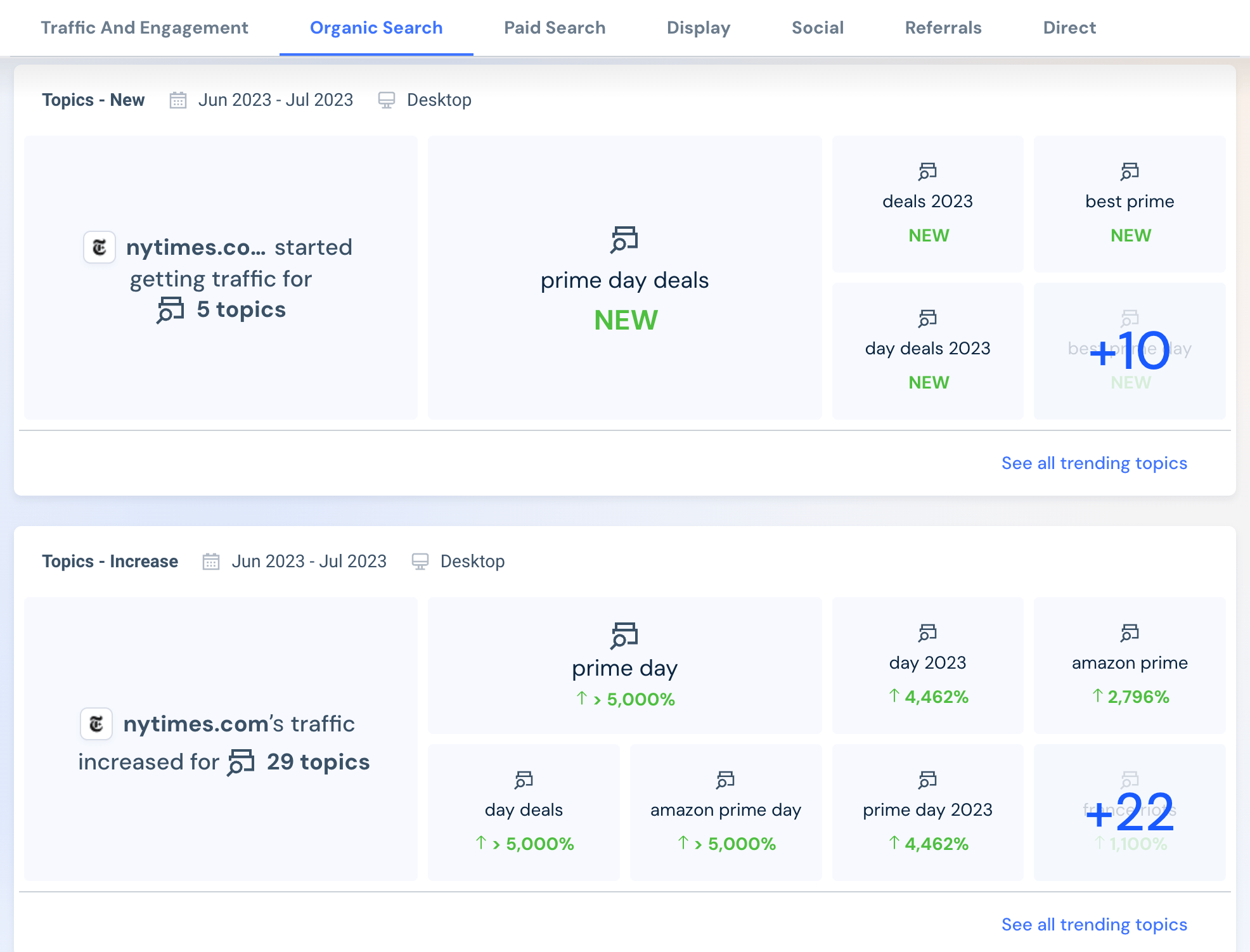
Here you see that CNN’s close competitor, the NY Times, increased their traffic for over 25 topics in the last month, and there are nearly 15 new ones on the horizon. With these super fresh insights you can dive into the topics and keywords driving traffic for your competitors and strategize ways to redirect it to your own website.
Paid ad analysis: see how many paid ads your competitors have launched, what they’ve been bidding on and get a peek into their ad creatives
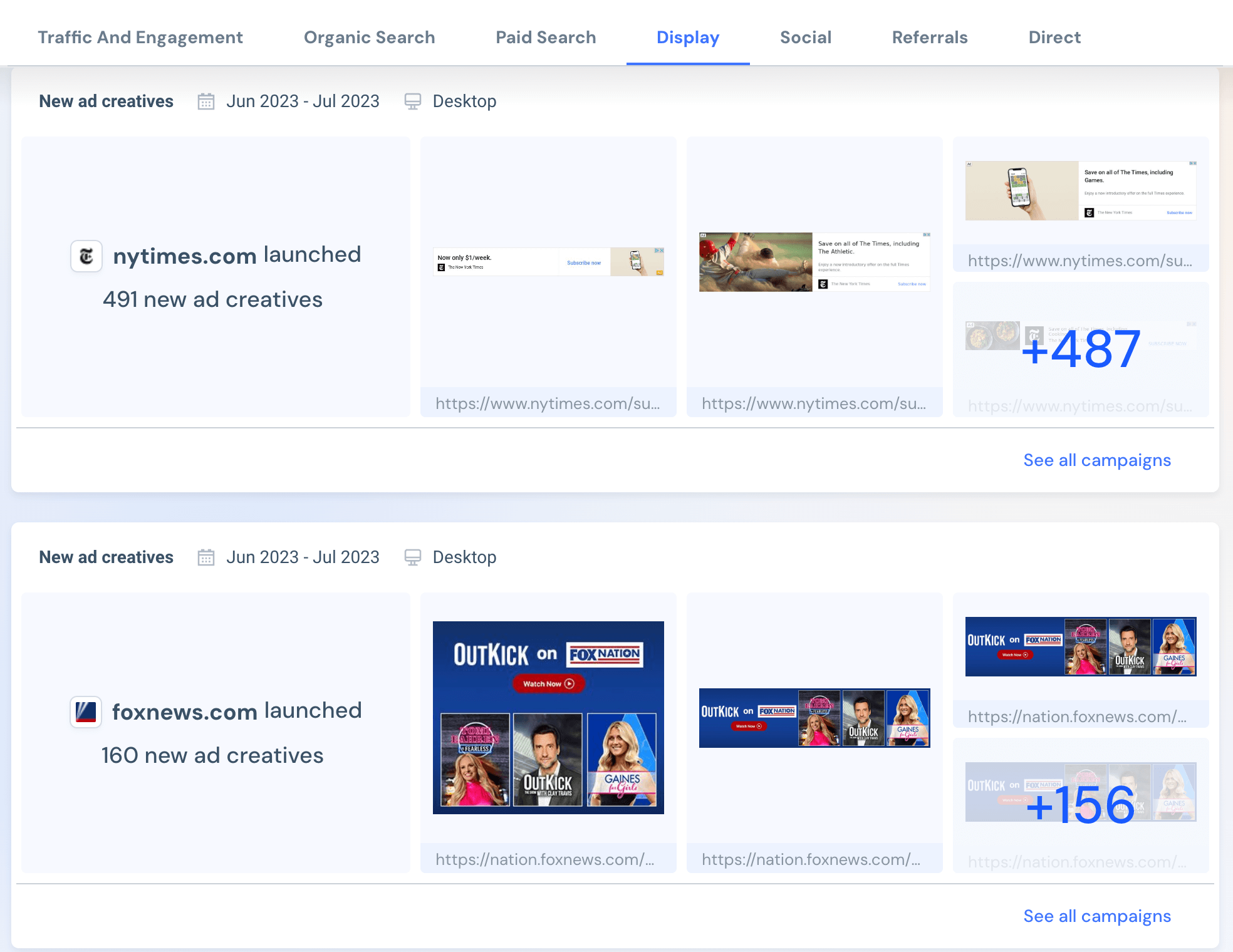
The Competitive Tracker will become your go-to resource for quick, actionable insights.
Another weapon to have in your competitive monitoring arsenal: Similarweb’s Custom Market Analysis tool.
While a broad overview of your competitors’ performance has its advantages, what you’re really after is super relevant and targeted analysis.
With the Custom Market Analysis tool, you can get the competitive edge by delving right into website segments and custom industries and scrutinizing categories, lines of business and even specific types of web pages.
Our Custom Market Analysis tool’s best bits:
Website Segments: Focus on specific pages or sections within a website for more targeted analysis
Custom Industries: Create tailored industries to benchmark against, capturing insights specific to your market niche
Key Digital Metrics: Uncover detailed metrics like user engagement, traffic sources, and conversion rates for each segment or custom industry.
By digging into more specialized areas you’ll not only add another layer of precision but you’ll be able to spot opportunities that your competitors have missed. Outsmart them by understanding and acting on market subtleties they’ve overlooked.
What are the most critical competitor data points to track?
It’s important to track a variety of metrics to get a truly holistic view of your competitor’s websites. Your goal is to understand their full performance across channels. Here are a few different metrics we suggest tracking:
Website traffic
Understanding your competitors’ traffic sources can uncover a lot of interesting insights. With Similarweb, you can check competitors’ website traffic and reveal exactly how much traffic your competitors are getting over time from:
- Direct
- Referrals
- Search
- Social
- Display Ads

Seeing which inbound traffic sources are strongest (and weakest) is highly valuable for marketing and sales strategies in terms of traffic quantity and quality. You’ll be able to see which tactics are working well for your rivals, and which aren’t, as well as analyze traffic gaps and refine your strategy.
This will help you and your team revise your marketing tactics to both take inspiration from the competition, as well as fill in the gaps that others in your niche have neglected.
Targeted keywords
Wouldn’t it be great to know which keywords your rivals are ranking for? Are there any you’ve missed and need to optimize for on your website? Is one particular brand killing it with seasonal keyword trends? If you want to carry out the best competitive SEO analysis possible, you’ll need access to the most targeted keyword data out there.
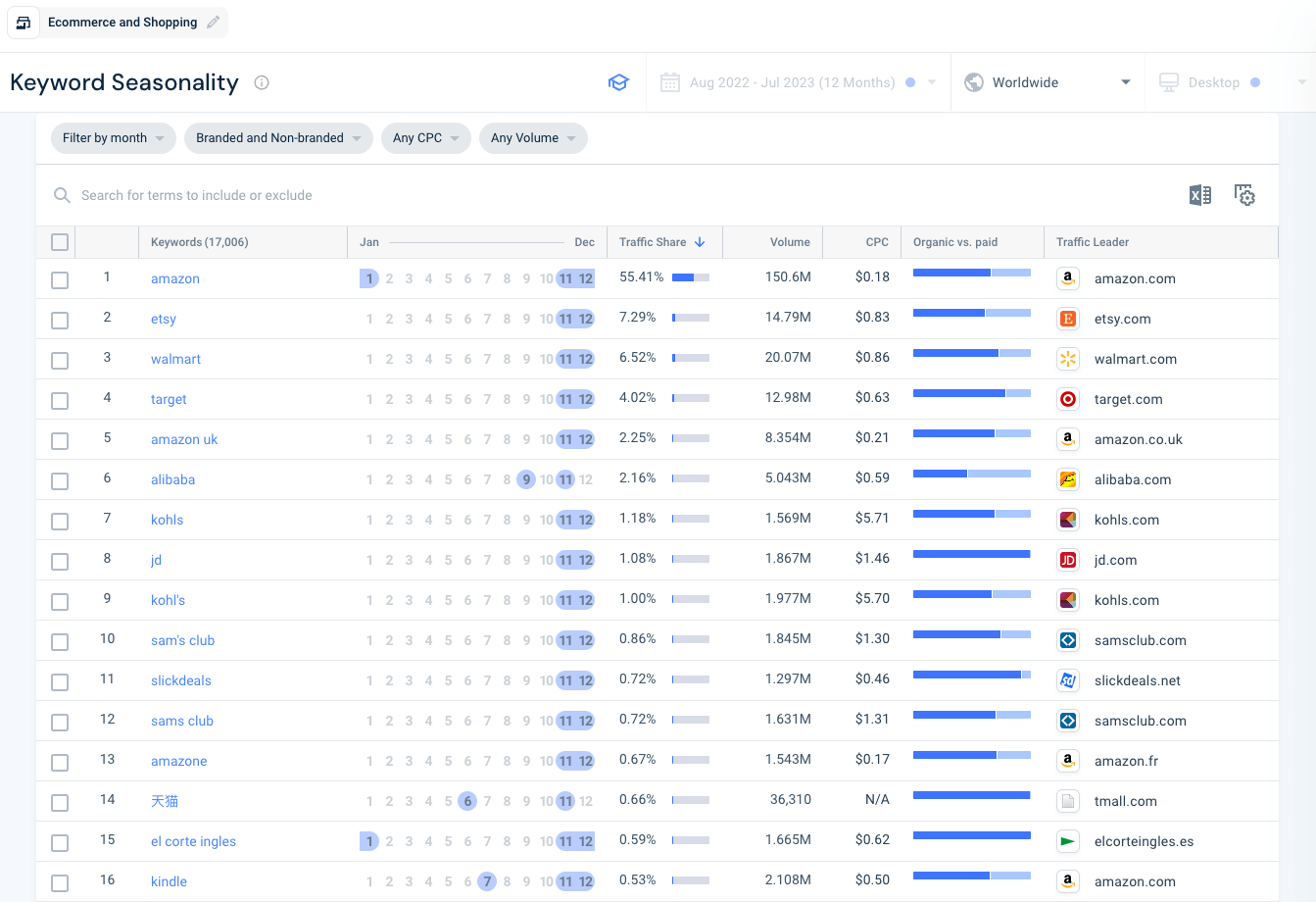
Keyword data is a treasure trove of information that will help your business improve its SEO strategies — from keyword gaps to seasonal keywords.
Competitive SEO analysis, including competitive keyword research and competitive content analysis, should be performed regularly to discover new keyword opportunities and blog topic ideas.
Rank tracking
Keep a close eye on the rankings of your pages vs. your competitor pages. Use Similarweb’s Rank Tracker to stay on top of all relevant ranking data per keyword and URL.
You can:
- Monitor the SERPs – analyze your standing against competitors and look out for newcomers disrupting the search landscape
- Track trends and rank changes – monitor fluctuations in rank and rising/declining keywords so you can quickly change tact before competitors do
- Monitor competitors – track up to 5 competitors at daily granularity to zone in on their rankings and SEO strategies
Display ads
To improve your own ad campaign strategies, start by taking a look into what is (and isn’t) working for your competitors.
Similarweb Display Overview reveals insights on the top publishers, top ad networks, and key insights on traffic and engagement. You can also easily identify the publishers and ad networks your competitors are working with to acquire more traffic, as well as exactly which ads are performing best for your rivals. This can give your creatives juicy ideas on how to best optimize your own ad campaigns.
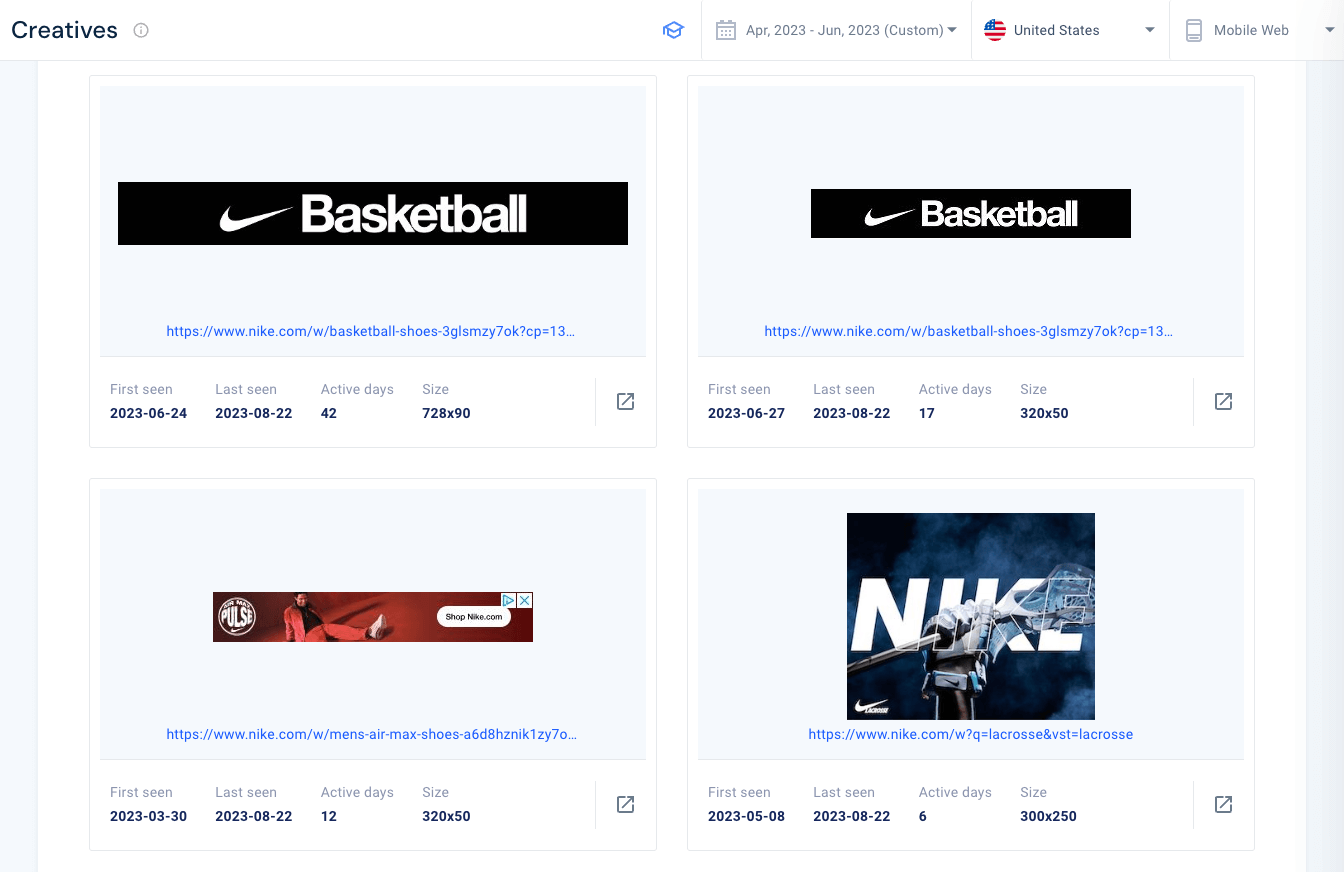
Paid search
Paid search campaigns need fresh data to stay ahead of the competition.
Similarweb Paid Search Overview gives a unique view of when and how other brands are driving paid traffic, as well as reveals what paid channels they use. Analyze your PPC competitors and get a holistic view of their PPC strategy through metrics such as:
- Total paid search traffic as a percentage of all search traffic
- Top paid keywords driving traffic to websites – with a view on traffic share, CPC, and volume
- Paid search traffic over time – filtered by day, week, or month
- PPC spend over time
- Paid search engagement metrics
- Top search ads
- Top product ads
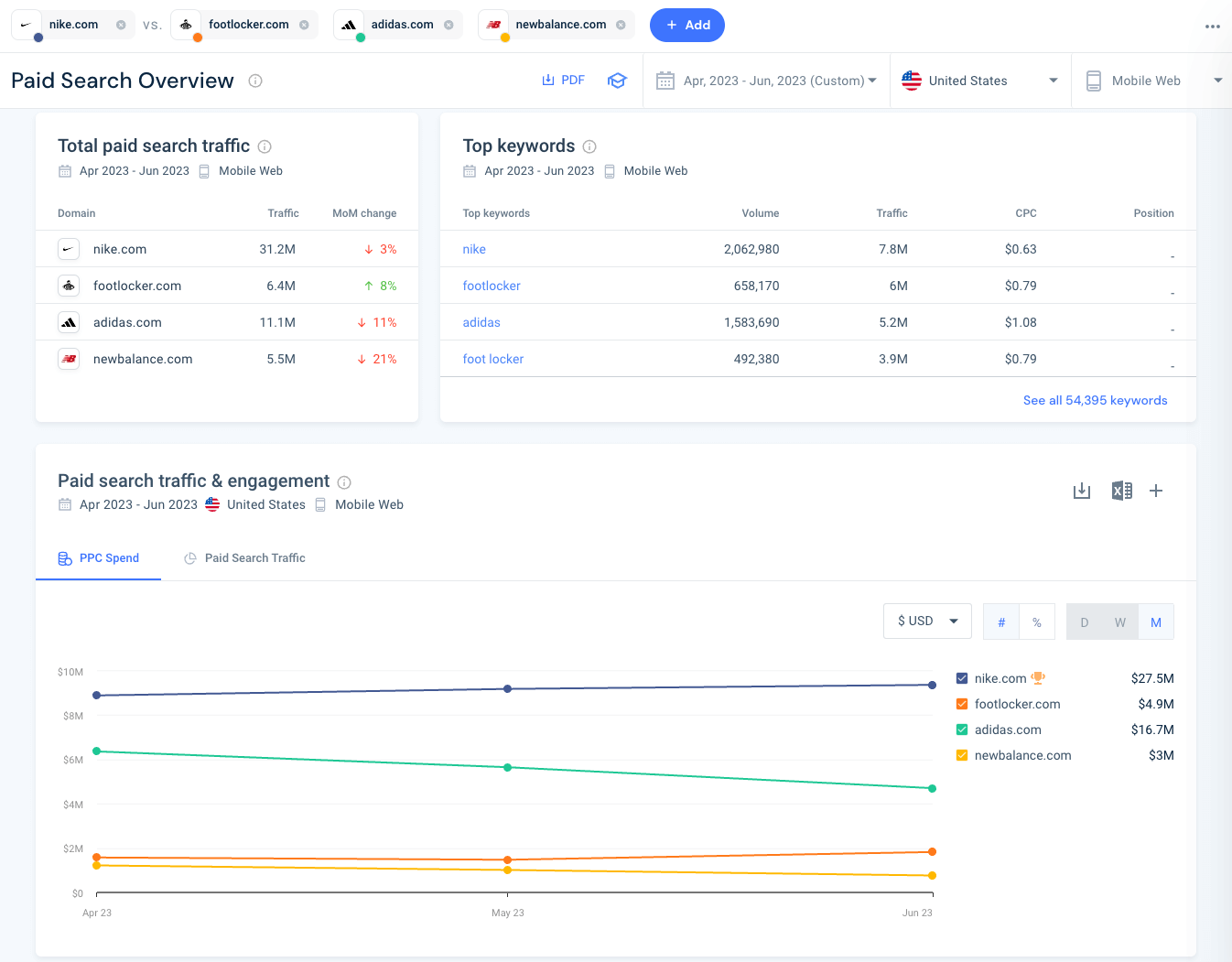
Social activity
Examine the percentage of traffic sent from your competitors’ various social pages, amount of social visits, and changes in their social traffic over time.
For example, you discover your competitors aren’t posting on Instagram, so you decide to capitalize on their shortcomings and build up a booming presence there. Going boldly where no one else has gone before, while perhaps a bit risky, can also reap big rewards.
Referrals
Monitoring referral traffic, incoming and outgoing, can reveal new potential affiliate marketing opportunities and affiliate networks.
Referrals include traffic from:
- Affiliates
- Backlinks
- Content partners
- Direct media buying
- News coverage
For example, you discover that your biggest competitor brings in tons of customers through one specific referral – if you manage to win a partnership for your own organization, it could hugely improve your bottom line.
Email marketing
A smart competitive strategy could be sitting right in your inbox.
Try signing up for your biggest competitors’ newsletters and email campaigns. See what email marketing tactics they use, what offerings they do and don’t promote, what kinds of sales they have, etc.
It’s one of the most effortless ways to monitor your competitors, as it lands straight to your inbox each day.
Recent acquisitions and investment in new technology
Stay up-to-date on when competitors add a new technology to their stack or make an acquisition. This indicates new capabilities and directions your competitors are heading in. This information is useful for refining and adjusting your own strategies.
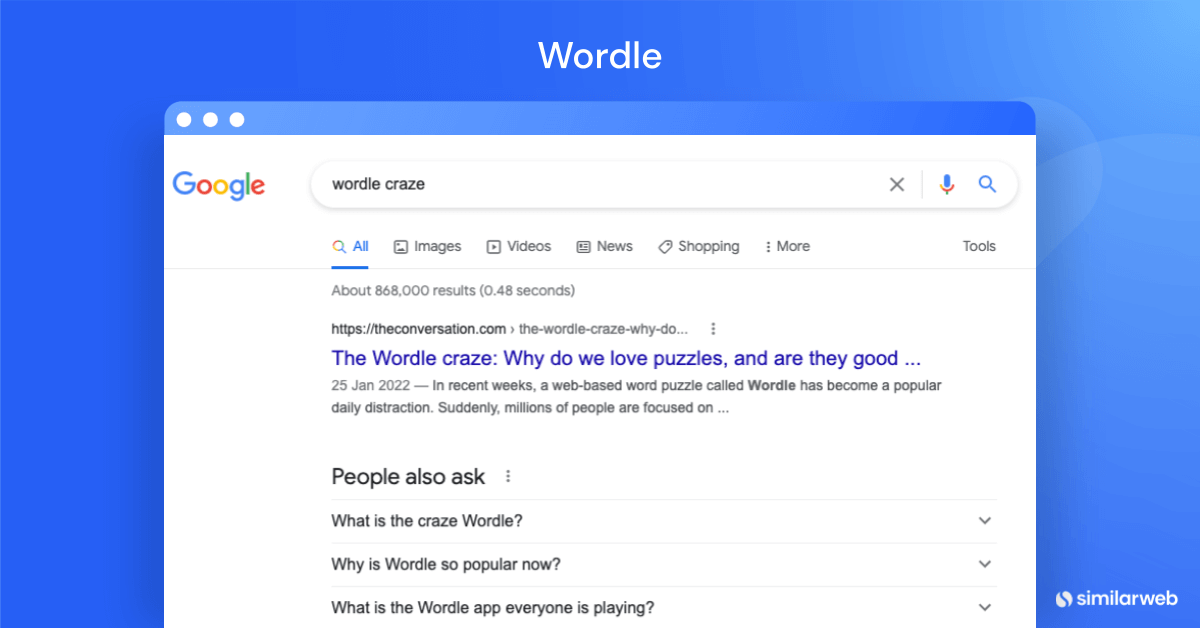
Board members and investors
Do some research into who sits on the board of your top competitors, as well as who invests in them. Understanding what their backgrounds are as well as what past strategies they’ve used for success can provide some potential insights into what your competitor’s future plans may look like.
News mentions
Go to Google Alerts and sign up to be alerted each time your competitors’ names are mentioned in the news. This way, you’ll always be caught up on all their latest updates – from new product announcements and market positioning to new rounds of funding and social media splashes.
Time to get trackin’!
In today’s fast-paced, ever-changing digital world, competitor analysis, and ongoing monitoring are now a basic necessity. From understanding the nitty-gritty of your competitors’ strategies to grasping the bigger picture of your industry’s landscape, you’re now armed with all the tricks, tips and tools you need.
We’ve discovered some quick and easy tactics, like signing up for competitor emails and setting up Google Alerts. Others require more time and effort but will take you beyond mere observations to dive deep into actionable insights that will make you a proactive market leader.
See what insights you can gain and how you stack up against the competition with Similarweb’s Competitive Intelligence Analysis tools.
FAQs
Why should I monitor both direct and indirect competitors?
Direct competitors offer products or services similar to yours and pose an immediate threat to your market share. Indirect competitors serve the same consumer base but offer different types of products or services. Monitoring both gives you a complete view of your competitive landscape. Direct competitors help you understand your immediate threats, while indirect competitors provide insights into broader market trends and untapped opportunities.
Who in my business should be involved in competitive monitoring?
Competitive monitoring is not just for one department; it can benefit almost every aspect of your business. Leadership teams can make informed strategic decisions, product teams can identify areas for innovation, business development teams can spot new market opportunities, marketing teams can refine strategies, and sales teams can better position your offerings against competitors.
How can Similarweb help with competitive monitoring?
Similarweb offers a suite of competitive intelligence analysis tools designed to make the process more efficient and insightful. The Competitive Tracker tool, for instance, allows you to monitor up to 25 competitors and provides metrics like audience overlap, channel-specific insights, user engagement, keyword trends, and paid ad analysis. These tools offer a detailed understanding of your competitors’ strategies and performance.
What key metrics should I track to understand my competitors better?
Important metrics to consider include website traffic from various sources (direct, mail, referrals, search, social, display ads), targeted keywords, rank tracking, display ads performance, paid search strategies, social activity, referrals, and email marketing tactics. These data points provide a comprehensive view of your competitors’ online performance and strategy.
Your full marketing toolkit for a winning strategy
The ultimate solution to help you build the best digital strategy








